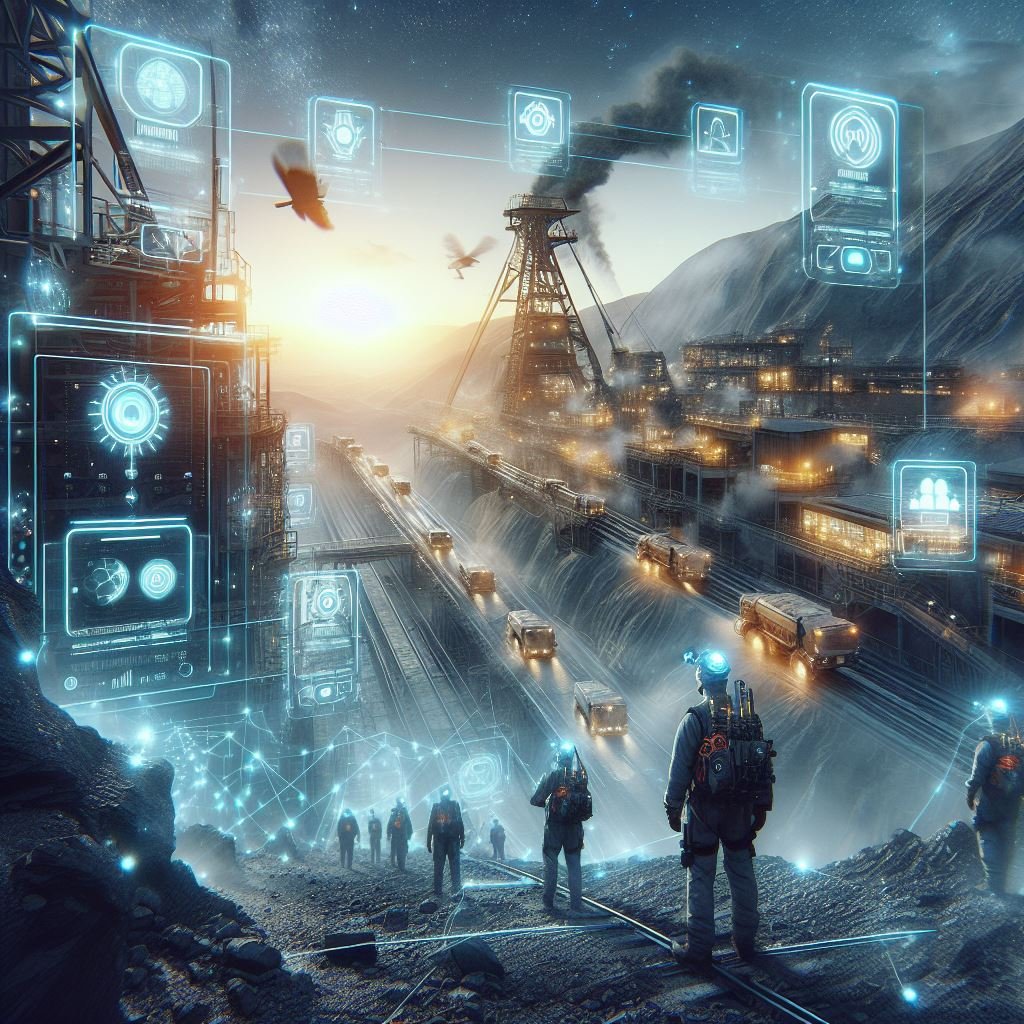Date: 18-05-2024
AI EXPLORER
Newsletter
- kamaliyagroup.com
- May 24, 2024
- 5:10 pm
- One Comment

Welcome to AI EXPLORER
AI Explore is a newsletter dedicated to keeping readers informed about the latest developments in artificial intelligence. From breakthroughs in machine learning to advancements in robotics, AI Explore provides a comprehensive overview of the rapidly evolving field of AI.
Whether you are a seasoned AI professional or simply curious about the future of technology, AI Explore delivers insightful and engaging content straight to your inbox. Stay ahead of the curve with AI Explore.
History of AI Development:
“On May 24, researchers and companies were likely engaged in developing and refining neural network architectures that would lead to breakthroughs in image recognition, natural language processing, and other areas. The publication of influential papers and the release of powerful AI frameworks were common during this period.
AI EXPLORER

Reflection. Let us know your view by replying to this email.
aks@kamaliyagroup.in
Referral code -aksquarry014
AI News
AI News: Scarlett Johansson vs. OpenAI

Scarlett Johansson has taken legal action against OpenAI, demanding the removal of a voice for ChatGPT that closely resembles hers. Johansson, known for her voiceover work in the sci-fi film “Her,” declined an offer from OpenAI to collaborate, yet was shocked to hear a voice eerily similar to hers in a recent demo. Her lawyers are now seeking details on the creation process of this voice. OpenAI has agreed to remove the voice but maintains it was created with professional voice actors and is not an imitation of Johansson. However, CEO Sam Altman’s cryptic tweet, “Her,” has intensified the controversy.
AI-Generated Kids Draw Predators on Social Media
In related AI news, AI-generated children’s drawings are causing a stir on TikTok and Instagram. These playful and creative renditions, often depicting imaginary creatures and “predators,” have captivated audiences, blending art and technology in a novel way.
Google’s AI Overhaul Faces Backlash
Google’s recent AI-related announcements have been met with mixed reactions. At its annual developer conference, Google introduced AI-generated summaries for search results, but users have criticized the feature for inaccuracies. The tech giant also launched enhancements to Google Lens, enabling video-based searches, and rolled out AI-powered tools in Workspace products. Despite these innovations, user frustration with erroneous AI summaries is growing.
Google’s New AI Tools and Collaborations
To promote its new video and music creation AI tools, Google has enlisted celebrities like Donald Glover and Wyclef Jean. Additionally, Google’s AI model Gemini 1.5 will enhance Google Drive, Docs, Slides, Sheets, and Gmail with advanced search and content generation capabilities.
DeepMind’s Project Astra
DeepMind CEO Demis Hassabis introduced Project Astra, an advanced multimodal AI assistant capable of seeing, hearing, and understanding its environment. In a demonstration, Astra showcased its versatility by fixing code, creating band names, and locating lost items, highlighting the potential of AI to integrate seamlessly into daily tasks.
AI News: Helsing Raises Funds at $4 Billion Valuation in Major Defense Tech Bet

May 24, 2024 – Helsing, a cutting-edge AI startup specializing in defense technology, is making headlines with its latest funding round. The company has successfully raised significant capital, propelling its valuation to an impressive $4 billion. This monumental financial milestone underscores the growing confidence and investment in AI-driven defense solutions.
Helsing’s innovative approach leverages artificial intelligence to enhance national security, providing advanced surveillance, threat detection, and decision-making capabilities to defense agencies worldwide. The startup’s technology integrates machine learning algorithms with real-time data processing, offering unprecedented situational awareness and strategic advantages on the battlefield.
Investors are keen on Helsing’s potential to revolutionize defense technology, reflecting a broader trend of increasing reliance on AI for national security. As geopolitical tensions and technological advancements escalate, the demand for sophisticated AI-driven defense systems continues to rise.
Helsing’s latest funding round is not just a financial victory but a testament to the critical role of AI in modern defense strategies. The company’s growth and innovation promise to reshape the future of defense technology, providing enhanced safety and security on a global scale.
Stay tuned for more updates on Helsing’s journey and the transformative impact of AI in the defense sector.
Canva Emerges as Go-To Platform for Creative Design

In a recent development, Canva, the popular online design platform, is making waves across industries as users rave about its user-friendly interface and powerful design tools. From small businesses to large corporations, Canva is becoming the go-to solution for all things design-related.
Users express their delight at the platform’s simplicity, highlighting the ability to create professional-grade designs without the need for extensive design expertise or hiring external designers. “I don’t have to hire somebody to do this. Yeah, I can just do it real quick on Canva. We have literally used Canva in all of our business,” shares one enthusiastic user.
Another user, who admits to being a beginner in design, praises Canva for making them feel like an expert. “I made the label and the logo using Canva. I’m a beginner at this, but Canva has made me feel like an expert,” they remark.
Canva’s AI-powered tools also receive high praise, with users hailing them as a “secret weapon” for enhancing their creative projects. “I have to talk about Canva’s AI tools because they’re really good. Canva is like a secret weapon for me,” says a satisfied user.
The platform’s impact goes beyond individual users, with Canva empowering teams to produce stunning designs internally. “Oh, I feel like a creative superhero. It fills me with actual confidence,” exclaims one team member, reflecting the sentiment echoed by many others.
Canva’s democratization of design is evident as users proudly showcase their creations, often eliciting surprise from others who assume professional designers were involved. “How did you do those slides? Can I get the number to your designer? I’m like, It’s Canva, baby. I did it myself,” shares a delighted user.
As Canva continues to revolutionize the way people approach design, it reinforces the notion that creativity knows no bounds. With its intuitive platform and robust feature set, Canva is empowering individuals and teams to unleash their creativity like never before.
Stay tuned for more updates on Canva’s journey as it continues to redefine the landscape of creative design.
AI Agents Move Towards Greater Autonomy
The field of AI agents – autonomous software systems that can complete tasks and make decisions – is rapidly advancing, promising to revolutionize how we interact with computers and automate workflows.
One pioneer in this area is Yohi Nakajima, who made waves last year with his open-source project “Baby AGI” – an early experiment in building an autonomous AI agent that could reason, set goals, and take actions to achieve those goals. While rudimentary, Baby AGI demonstrated the potential for creating AI assistants that operate with greater independence than today’s language models.
“Most of what’s been out so far, the AI will actually ask you if you want it to take the next step,” Nakajima explained. “I feel like people want to be able to give it a prompt, walk away, go to dinner, and come back with their task completed.”
While today’s AI agents still rely heavily on human oversight, researchers are making strides towards true autonomy. Startups like Anthropic’s newly-minted $2 billion unicorn Devan are building AI assistants to automate coding workflows with minimal human involvement.
As the technology matures, some envision AI agents taking on increasingly complex roles – like serving as autonomous CEOs able to communicate with employees, access company data, and make consistent decisions 24/7.
However, the prospect of autonomous AI systems also raises ethical concerns around job displacement, privacy, and potential misuse that will need to be carefully navigated.
“We’re all still trying to discover what are the correct design patterns and UX for autonomous agents to work well and safely,” said Nakajima. “But the autonomy of these systems will have a huge impact – it’s just a matter of when, not if.”
While full autonomy remains some years away, AI agents are already demonstrating their potential to radically boost productivity and automate time-consuming tasks. As the field rapidly evolves, businesses and developers are exploring how to harness this transformative technology.
Latest AI TOOLS - Dated: May 24, 24
| Name of tool | URL/Link | Purpose/Use |
| LARQ | LARQ | Assess audience retention with ease by implementing quizzes directly into live meetings, videos, or PDFs using LARQ’s innovative platform. |
| Sprig | Sprig | Gather continuous feedback directly within your product or website using Sprig, a tool that enables seamless feedback collection from users. |
| Verta RAG System | Verta RAG System | Simplify prototype creation with the Verta RAG System, allowing users to develop trusted RAG prototypes without the need for coding expertise. |
| Cleft | Cleft | Express thoughts seamlessly and transform them into coherent notes with Cleft, a tool designed to help users articulate ideas effortlessly. |
| Wegic | Wegic | Bring your dream website to fruition with Wegic, offering intuitive tools to design and launch your ideal online platform. |
| Kintext | Kintext | Empower parenting with research-backed guidance from Kintext, assisting individuals in becoming the best parents possible. |
| Metaforms | Metaforms | Streamline form creation with Metaforms, enabling users to develop top-notch forms effortlessly. |
AI TRENDS, TECHNIQUES, AND REVOLUTIONS

The Integration of AI and Machine Learning in Mining Safety: A Promising Future
Abstract:
The integration of Artificial Intelligence (AI) and Machine Learning (ML) in mining safety represents a significant advancement in the industry. Recent developments in this field have showcased the transformative potential of AI and ML technologies in enhancing risk assessment, promoting workplace safety, and optimizing operational productivity in mining operations. This paper examines key points from recent news articles, highlighting the role of AI and ML in revolutionizing safety practices within the mining industry. Through the adoption of AI-enabled technologies such as real-time surveillance, automated hazard recognition, and wearable devices for safety monitoring, mining companies are poised to create safer working environments and drive operational efficiency.
Introduction:
The mining industry is inherently hazardous, characterized by dynamic environments, heavy machinery, and exposure to various risks. Ensuring the safety of workers while maintaining operational efficiency has been a longstanding challenge for mining companies. However, recent advancements in AI and ML technologies have opened up new possibilities for addressing these challenges. This paper explores how AI and ML are being leveraged to revolutionize safety practices in mining operations.
AI and Machine Learning in Risk Assessment:
One of the key applications of AI and ML in mining safety is in risk assessment. These technologies are being used to analyze vast amounts of data collected from mining operations, including geological data, equipment performance metrics, and historical incident reports. By applying advanced algorithms, AI and ML systems can predict safety incidents before they occur, allowing mining companies to proactively address potential risks and prevent accidents. This predictive approach to risk management represents a fundamental shift in the industry’s approach to safety, moving from reactive measures to proactive prevention strategies.
Vision AI for Mining Safety:
Vision AI is another area where significant progress has been made in improving mining safety. By utilizing real-time surveillance cameras and advanced image recognition algorithms, Vision AI systems can automatically detect hazards such as unstable ground conditions, equipment malfunctions, or unauthorized personnel in restricted areas. This capability is particularly valuable in the dynamic environments of mining operations, where conditions can change rapidly, and traditional safety measures may be insufficient. By providing timely alerts and warnings, Vision AI contributes to the prevention of accidents and the promotion of a culture of safety within mining companies.
AI in Operational Productivity:
In addition to enhancing safety, AI technology is also driving improvements in operational productivity within the mining industry. By analyzing operational data in real-time, AI systems can identify inefficiencies, optimize equipment utilization, and streamline workflow processes. This not only improves the overall efficiency of mining operations but also reduces downtime and enhances resource utilization. As a result, mining companies can achieve higher levels of productivity while maintaining the highest standards of safety.
Real-time Safety Monitoring:
AI-enabled wearable devices represent a cutting-edge solution for real-time safety monitoring in mining operations. These devices are equipped with sensors that can detect vital signs, environmental conditions, and other indicators of potential safety risks. By continuously monitoring workers for signs of fatigue, stress, or exposure to hazardous substances, AI-enabled wearables provide early warnings of potential safety hazards, allowing for prompt intervention and prevention of accidents. Moreover, by collecting and analyzing data over time, these devices can help identify trends and patterns that can inform proactive safety measures and training programs.
Conclusion:
The integration of AI and Machine Learning in mining safety represents a significant step forward in the industry’s ongoing efforts to create safer and more efficient working environments. By harnessing the power of predictive analytics, real-time surveillance, and wearable technology, mining companies can proactively identify and mitigate safety risks, thereby protecting the well-being of their workers and optimizing operational productivity. As these technologies continue to evolve, the future of mining safety looks increasingly promising, with AI and ML playing a central role in shaping the industry’s approach to safety and risk management.
Integrating AI Agents Into Your Business: A Framework for Successful Adoption
Abstract:
The advent of advanced artificial intelligence (AI) agents presents businesses with immense opportunities to streamline processes, enhance productivity, and drive innovation. However, the integration of these intelligent systems into existing business operations requires a well-structured approach to ensure successful adoption and realization of their full potential. This paper proposes a comprehensive framework for businesses to effectively incorporate AI agents into their workflows, considering critical factors such as goal alignment, stakeholder impact, performance evaluation, ethical considerations, and continuous improvement.
Introduction:
AI agents, powered by cutting-edge technologies like large language models and machine learning, have the capability to automate a wide range of tasks, from project management and content creation to customer service and predictive analytics. As these agents become increasingly sophisticated, businesses are recognizing the need to strategically integrate them into their operations to remain competitive and drive efficiency. However, the adoption of AI agents is not without challenges, and a structured framework is necessary to navigate the complexities and ensure successful implementation.
The AI Agent Integration Framework:
1. Identify Clear Business Goals:
The first step in integrating AI agents is to identify clear business goals that the agent should address. These goals may include automating repetitive tasks, expanding to new markets, optimizing logistics, or improving customer service. By defining specific objectives, businesses can better evaluate the suitability of potential AI agents and measure their impact.
2. Consider Stakeholder Impact:
The integration of AI agents can have far-reaching implications for various stakeholders, including employees, customers, and investors. It is crucial to consider the impact on all stakeholders and seek diverse perspectives to identify their needs, desired impacts, and potential pushbacks or issues. This inclusive approach fosters a smooth transition and ensures that the agent’s implementation aligns with the organization’s values and objectives.
3. Determine Key Performance Indicators (KPIs):
Establishing clear KPIs is essential for measuring the success of the AI agent. These KPIs can range from accuracy and speed to user satisfaction scores or return on investment (ROI). For instance, a customer service AI assistant might be evaluated for response accuracy and customer satisfaction, while a predictive analytics agent might be assessed based on the precision and recall of its forecasts.
4. Thoughtful Agent Selection:
Businesses must carefully choose which AI agent to implement, considering factors such as its suitability for the identified business goal, integration with the current and projected tech ecosystem, security and compliance with relevant regulations, and ethical operation. Evaluating the provider’s commitment to ethical practices, reviewing documentation for transparency, assessing bias mitigation strategies, and ensuring the ability to audit and correct decisions are crucial steps in this process.
5. Data Quality and Preparation:
Ensuring the accuracy, comprehensiveness, and cleanliness of the data fed into the AI agent is paramount for obtaining accurate outputs and recommendations. Businesses should invest in data preparation processes to optimize the agent’s performance.
6. Gradual Introduction and Integration:
To minimize disruption, businesses should gradually introduce the AI agent into their processes, scaling up and integrating it more extensively once its helpfulness has been proven. This approach allows for a smoother transition and minimizes potential risks.
7. Employee Training and Adoption:
Training employees on how to leverage the AI agent effectively is crucial for increasing the likelihood of successful outcomes. Businesses should invest in comprehensive training programs and encourage employee adoption to maximize the agent’s impact.
8. Continuous Monitoring and Feedback:
Continuously monitoring the AI agent’s performance is essential to ensure that it meets intended goals. Businesses should measure pre-determined KPIs, collect feedback from employees and customers through surveys or user behavior analysis, and analyze this data to identify areas for improvement.
9. Iterative Improvement:
Based on the AI agent’s performance and feedback, businesses should make necessary adjustments, such as retraining it with additional data or altering interaction designs, to optimize its effectiveness.
10. Staying Informed and Adapting:
The field of AI is rapidly evolving, and businesses should stay informed about advancements in the field. This knowledge can help organizations determine whether they need to adjust current workflows, implement new tools, or augment additional business processes with AI agents.
Conclusion:
The integration of AI agents into business operations presents a significant opportunity for organizations to enhance efficiency, productivity, and innovation. However, successful adoption requires a structured framework that considers factors such as goal alignment, stakeholder impact, performance evaluation, ethical considerations, and continuous improvement. By following the proposed framework, businesses can navigate the complexities of AI agent integration and unlock the full potential of these advanced technologies.
Designing Intelligence: A Multidisciplinary Exploration
Abstract:
In this research paper, we explore the concept of design as intelligence made visible, extending its application beyond traditional realms to encompass writing, software engineering, and life itself. Drawing inspiration from Louis Danziger’s definition of design, we delve into the interconnectedness of design principles and their relevance across various domains. Additionally, we examine recent advancements in artificial intelligence (AI), including OpenAI’s Chat GPT-4o, a bot with enhanced speech capabilities, and their implications for app development. Furthermore, we discuss a new study on the H5N1 avian flu outbreak and provide insights into life with Long Covid, underscoring the multifaceted nature of intelligence and design.
Introduction:
The concept of design as intelligence made visible encapsulates the idea that thoughtful creation reflects underlying intelligence. This principle resonates not only in traditional design disciplines but also in writing, software engineering, and everyday interactions. By exploring the fundamental principles of design and their applicability across diverse domains, we gain a deeper understanding of the interconnectedness of intelligence and creativity.
Design Principles Across Domains:
We begin by examining Taras Bakusevych’s “58 rules for beautiful UI design,” which outlines principles rooted in empathy, layout, essentialism, guidance, aesthetics, novelty, consistency, and engagement. While originally formulated for UI design, these principles can be extrapolated to writing, software engineering, and life itself. For instance, empathy in design translates to understanding the audience in writing, anticipating user needs in software engineering, and fostering meaningful connections in interpersonal relationships.
Implications of AI Advancements:
Recent developments in AI, exemplified by OpenAI’s Chat GPT-4o, signify a convergence of design and intelligence in technology. The bot’s enhanced speech capabilities reflect advancements in natural language processing and human-like interaction. Beyond its immediate utility, Chat GPT-4o heralds broader implications for app development, promising smarter, faster, and more efficient solutions.
Insights from Scientific Studies:
The discussion extends to scientific studies, including research on the H5N1 avian flu outbreak and the prevalence of Long Covid. Insights from vaccine scientist Chris Buck underscore the complexity of viral transmission, highlighting the importance of interdisciplinary approaches in combating infectious diseases. Similarly, firsthand accounts of Long Covid shed light on the enduring impact of the pandemic, emphasizing the need for empathy and resilience in navigating health challenges.
Conclusion:
In conclusion, the concept of design as intelligence made visible serves as a unifying framework for understanding creativity, problem-solving, and human interaction. By applying design principles across domains and embracing technological advancements with discernment, we can harness the power of intelligence to address complex challenges and cultivate a more inclusive and sustainable future.

Получите качественную юридическую помощь онлайн на сайте юридическая консультация[/url>.
Значение юридической помощи в сегодняшнем обществе. Запутанные правовые дела требуют помощи экспертов. Посещение юриста помогает понять сложные правовые аспекты.
Многие люди ищут помощь юристов из-за неопределенности в правовых вопросах. Некоторые услуги могут быть необходимы в экстренных ситуациях. Необходимо обратиться к опытному юристу для эффективного разрешения вопросов.
На данном сайте представлено много данных о том, как получить юридическую помощь. На сайте указаны телефоны и адреса опытных юристов для обращения. Знание, к какому юристу обратиться, может значительно облегчить решение проблемы.
Профессиональная юридическая помощь — это гарант вашего спокойствия. Не бойтесь задавать вопросы и выяснять нюансы. Юристы всегда готовы поддержать вас в решении правовых задач.